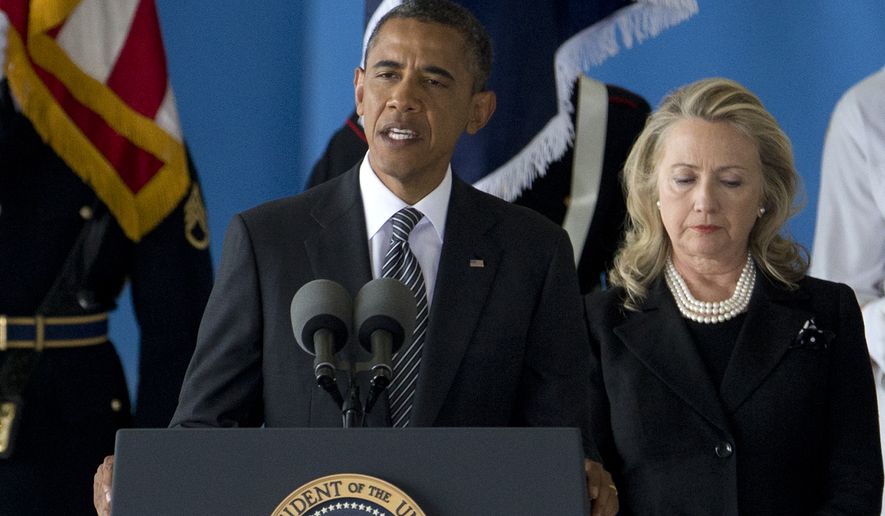OPINION:
The scandal of Benghazi is one that has plagued the Obama administration repeatedly — the effort to deflect attention from failed American foreign policy and the rise of terrorism — through a conscious spin effort that hid the truth from the American public.
In the end, it worked. President Barack Obama was re-elected and Hillary Clinton is now leading in the polls to become his successor.
But before you cast your vote in November, you should read the House Benghazi report released Tuesday — to at least recognize how self-interested politicians have become.
The Obama administration knew attacks on the consulate were because of terrorism, but they knowingly changed the narrative to blame an “inflammatory” viral video — to escape any culpability of the attacks so close to a November election. In the 2012 campaign, Mr. Obama repeatedly spoke of not only killing Osama bin Laden, but how Al Qaeda had been “decimated” under his watch. Any word Benghazi was actually a terrorist attack would undermine this narrative.
In her first public comment on the attack on Sept. 11, 2012, Mrs. Clinton’s first public statement released at 10:08 p.m. blamed the attack on a viral video.
“I condemn in the strongest terms the attack on our mission in Benghazi today,” said Mrs. Clinton, then secretary of state. “Some have sought to justify this vicious behavior as a response to inflammatory material posted on the Internet.”
Privately, in a summary of a call between Mrs. Clinton and the President of Libya Mohammad al Magariaf about three hours earlier, there was no talk of a viral video, only terrorism.
“[O]ur diplomatic mission was attacked[.] … [T]here is a gun battle ongoing, which I understand Ansar as-Sharia [sic] is claiming responsibility for,” a transcript of the call read.
After Mrs. Clinton made her public statements, blaming the video, she then emailed her daughter with the truth: “Two of our officers were killed in Benghazi by an al Qaeda like group.”
The next day, Mrs. Clinton told the American public the administration was “working to determine the precise motivations” of those who carried out the assaults (just like the Orlando attack), but that “some have sought to justify this vicious behavior, along with the protest that took place at our Embassy in Cairo yesterday, as a response to inflammatory material posted on the internet.”
Privately, she told the Egyptian Prime minister: “We know that the attack in Libya had nothing to do with the film. It was a planned attack — not a protest. … Based on the information we saw today we believe the group that claimed responsibility for this was affiliated with al Qaeda.”
Another day goes by, and publicly Mrs. Clinton continues to blame the internet video in her remarks in Morocco.
On Sept. 14, White House spokesman Jay Carney, answering a question about Benghazi during a press conference, said: “We have no information to suggest that it was a preplanned attack. The unrest we’ve seen around the region has been in reaction to a video that Muslims, many Muslims find offensive. And while the violence is reprehensible and unjustified, it is not a reaction to the 9/11 anniversary that we know of, or to U.S. policy.”
This was a blatant lie. But it was spin directed from the top — Mr. Obama’s and Mrs. Clinton’s political future was at stake, after all.
An email sent to officials from White House foreign policy adviser Benjamin Rhodes — with the subject line, “goals” — shows the Benghazi narrative was: “To underscore that these protests are rooted in an Internet video, and not a broader failure of policy.”
But it was a broader failure of U.S. policy.
CIA Deputy Director Michael Morrell said in a written statement to the House Permanent Select Committee on Intelligence a few days later: “The critically important point is that the analysts considered this a terror attack from the very beginning.”
Mrs. Clinton blamed her changing public statements on differing intelligence reports she received in real-time. But there’s no evidence to suggest Mrs. Clinton had anything but clarity, right from the evening of the attack, that it was indeed terrorism.
Her public and private statements remained consistent, albeit at odds. Privately, there was no doubt the attack was terrorism; publicly, it was blamed on a video and protesting — despite there being no eyewitness accounts of a protest.
She knew. The administration knew. But it wasn’t politically expedient to admit. So a lie was created, the narrative set, and everyone stuck to it.




Please read our comment policy before commenting.